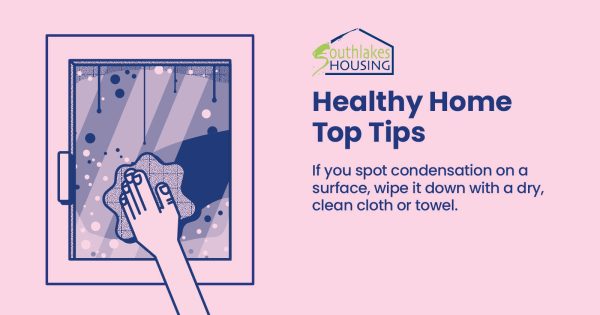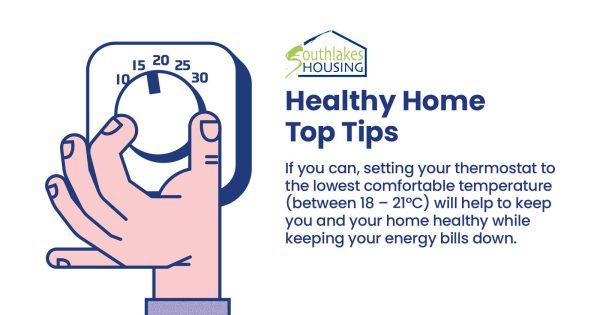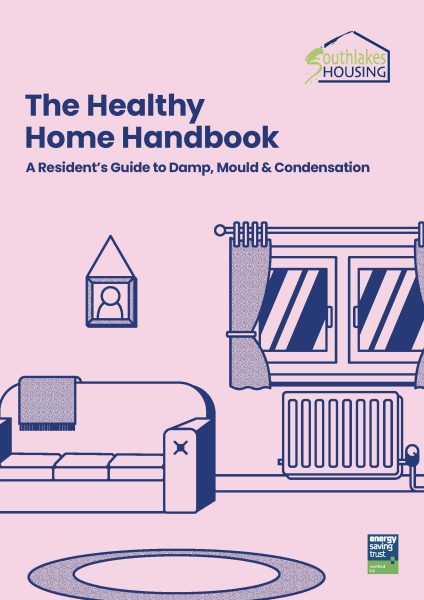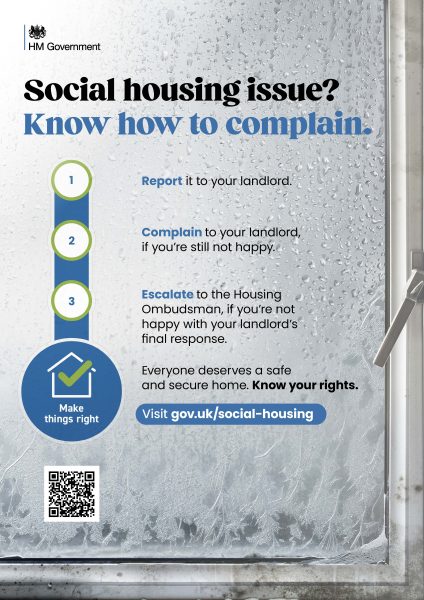Healthy Home – Damp, Mould and Condensation
Our priority and responsibility as a landlord is to provide you with a safe and healthy home. This includes a home that is free from damp, mould and excessive condensation.
All homes are at risk of condensation, particularly through the winter months.
If you have excess condensation in your home, this can lead to problems such as mould growth, which can affect your health and the health of your home.
Small amounts of condensation are not usually a problem, and there are some everyday things we can all do to help prevent it.
We have worked with Energy Saving Trust to create a Healthy Home handbook (above) and short video (below) to help you manage damp, mould and condensation and maintain a healthy home.
We also share information on the different types of damp so that you can identify any potential concerns and let us know if there is a problem.
If you spot any damp or mould in your home – or following these tips does not reduce excess condensation – let us know straight away on 0300 303 8540 and we’ll arrange to inspect so we can let you know the next steps.
This information is part of our overall response to damp, mould and condensation. You can read more about our policy and response to tackling damp and mould here.
There’s lots that can be done to prevent damp, mould and condensation from appearing in your home. If it does become a problem, there’s also lots we can do to help put things right.
Damp, mould and condensation are usually caused when there’s too much moisture in the air from doing normal day-to day things like boiling a kettle, drying clothes indoors, cooking or having a shower.
You might see condensation on your windows in the morning, or after you’ve had a bath, which is all normal, especially during winter. But if that moisture builds up and can’t get out, over time, it can cause damp and mould.
We want you to be safe and comfortable in your home. If you are concerned about damp or mould in your home and if you are or a member of your household is vulnerable due to age or health reasons please let us know. Prevention is always better than cure so if you think you’ve got a problem with damp, mould or condensation please email us or call us on 0300 303 8540 so we can investigate what’s causing the issue and see what we can do together to resolve it.
We will arrange a damp inspection for your home. During the inspection, we will:
- complete a full damp survey
- assess the structure of the property to see if this has caused the damp
- check the level of humidity to help you reduce condensation
- check your extractor fans are working
- take photographs and samples of any issues we find
Top healthy home tips to avoid damp, mould and condensation
Try and reduce the amount of moisture you produce

- Don’t boil kettles or pans longer than you need to.
- Make sure you put lids on saucepans when cooking.
- Open windows or use extractor fan (if fitted) when cooking.
- Wipe away condensation from windows and other surfaces.
- Avoid drying clothes on radiators and try to dry clothes outside or in your bathroom with the door closed and window open or extractor fan on.
- Close bathroom doors when bathing.
Improve the ventilation in your home
- Don’t overfill cupboards and wardrobes
- Put furniture near internal walls instead of external walls or against radiators
- Don’t block air vents or airbricks in your property.
- Open internal doors and windows occasionally to allow air circulation.
- Use ceiling fans (if fitted) and keep trickle vents in windows open.
Keep your home heated

- In cold weather provide a low background heat during the day.
- Don’t use bottled gas or paraffin heaters.
To help keep your home warm, you can also:
- tuck long curtains behind radiators
- keep doors closed to stop any draughts
- open your blinds and curtains when the sun is shining to allow the natural sunlight to warm up a room
We understand with the rising cost of energy bills you might be worried about putting your heating on. If you’re struggling with this, please give us a call on 0300 303 8540, and we’ll put you in touch with our friendly Income Team who’ll be happy to help you with advice and support.
Damp and mould can sometimes be due to an issue with your home. If you have tried our tips but it’s not making a difference, please let us know. It could be that we need to carry out some repairs or maintenance.
If you are concerned about damp and mould, please get in touch with us by calling 0300 303 8540, or alternatively you can email us at customerservices@southlakeshousing.co.uk
When contacting us, it’s important that you give as much information as possible. This detail should include:
- the areas of your home that are affected
- how long these areas have been affected
- any leaks or other plumbing issues that are causing the problems
- if the affected surfaces are wet to the touch
- if there is any visible discolouring, including black mould
- any smells in or near the affected areas
- any pealing of wallpaper and paint in or near the affected areas
We’d also like you to provide clear photographs that show the problem areas. These photos should include:
- clear, close-up detail of the affected areas
- a wider view of the affected area within the room
- any further photos that show important detail.
Everyone deserves a safe and secure home. If you live in social housing and you have an issue with your home or your landlord, there are ways to make things right.
For instances of damp & mould there is also information on the Make it Right website on how to follow the 3-step process to resolve any instances quickly.
FAQs
-
Q. There is damp and mould in my home. What should I do and how can SLH help?
A. If you notice any signs of damp or mould in your home, contact us by sending us an email or calling us on 0300 303 8540. We will arrange for a damp inspection of your home and clean down any affected areas. We’ll also look at what we can do to stop the damp and mould from coming back.
Finding the cause of damp and mould can sometimes be hard, but here are a few different things we can look at:
- Specialist treatment work to treat any problem areas
- Increasing the ventilation in your home using extra extractor fans which will help moisture to escape
- Installing mechanical ventilation systems which will help remove any moisture automatically
- Arrange for your homes’ damp proof course (DPC) to be checked. And if it needs repairing or replacing, we will get it fixed.
- Fit a device to help work out where the damp’s coming from so we can work out how best to deal with it.
-
Q. What are the main causes of condensation?
A.
- Not enough ventilation
- Producing too much moisture
- Temperature in your home being too low
- Drying clothes on radiators
Too much condensation can make your home feel damp and can give mould the right conditions to grow. Condensation is a greater problem during winter when the weather gets colder. This is because we tend to keep windows and doors closed to keep the heat inside, so the moisture cannot escape. This means that once the warm air hits any colder surfaces, the moisture it contains will condense.
Here are a few tips to stop condensation from damaging your home:
Make sure your home is heated- Keeping your home warm, so the temperature is between 18C and 21C, will help to prevent condensation. We understand with the rising cost of energy bills you might be worried about putting your heating on. If you’re struggling with this, please give us a call on 0300 303 8540, and we’ll put you in touch with our friendly Income Team who’ll be happy to help you with advice and support.
Dry your clothes outside if possible- Drying your clothes outside is one of the best ways to stop mould problems and condensation in your home. We understand that sometimes this isn’t possible so if you’re drying clothes inside make sure you open the windows and use extractor fans if you have them.
Ventilate your home- This will help reduce condensation by making the moist air escape outside.
- Open bedroom windows for 5-10 minutes when you get up.
- Keep a window open or turn your extractor fan on when you are cooking, in the bath or shower.
- Make sure ventilation grills in doors, windows or walls are not closed.
-
Q. What steps can I take against mould in my home?
A. If your home has condensation, it is possible that mould can grow, often as black spots on your walls, ceilings, furnishings and even on clothes and toys.
To kill and remove the mould, regularly follow these steps:
- Carefully remove excess mould with a damp cloth and throw away after. Do not brush mould as this releases spores into the air.
- Use rubber gloves to wipe down affected areas using a fungicidal wash or diluted bleach. Wearing safety glasses is recommended.
- Once the mould has been removed, redecorate using a good quality fungicidal / anti-mould paint.
- Dry clean mildewed clothes and shampoo carpets.
-
Q. What should I do if I notice watermarks in my home?
A. If you spot watermarks on your wall or ceiling, contact us by sending us an email or calling us on 0300 303 8540
Water or damp patches on walls or ceilings could be caused by:
- A leak in your roof
- Water coming in through the wall from outside
- A faulty damp proof course
One of our surveyors will need to visit your home to find out what is causing the watermarks so we can get things repaired to avoid further damage and mould growth.





